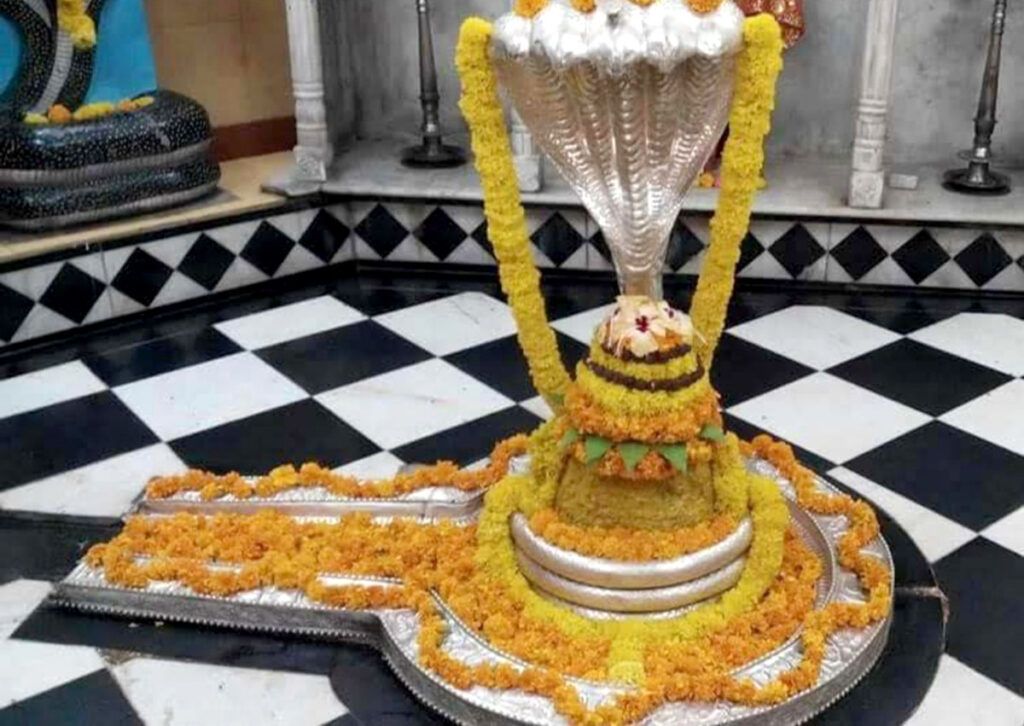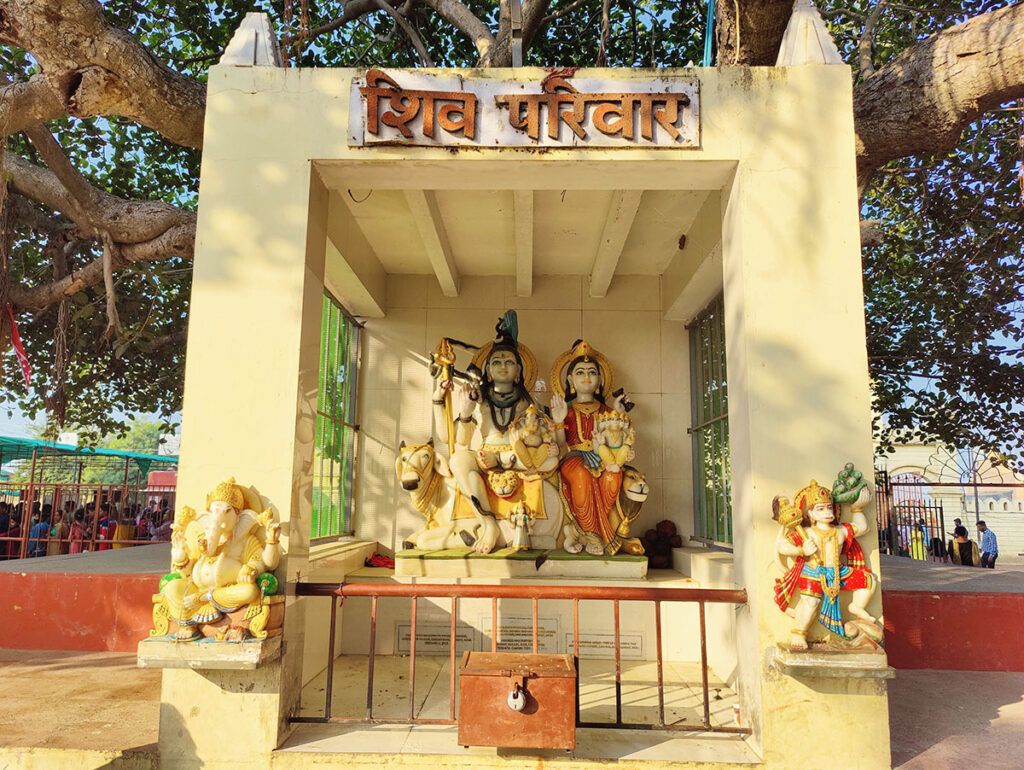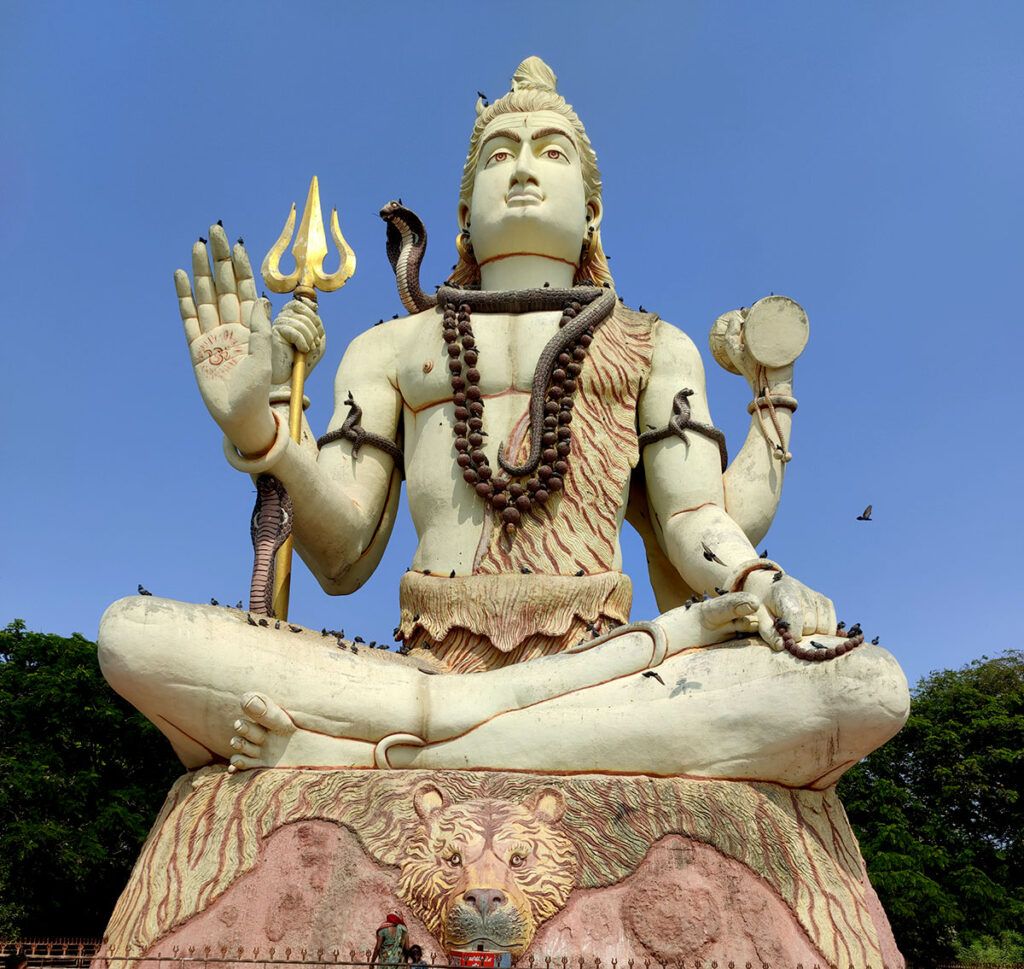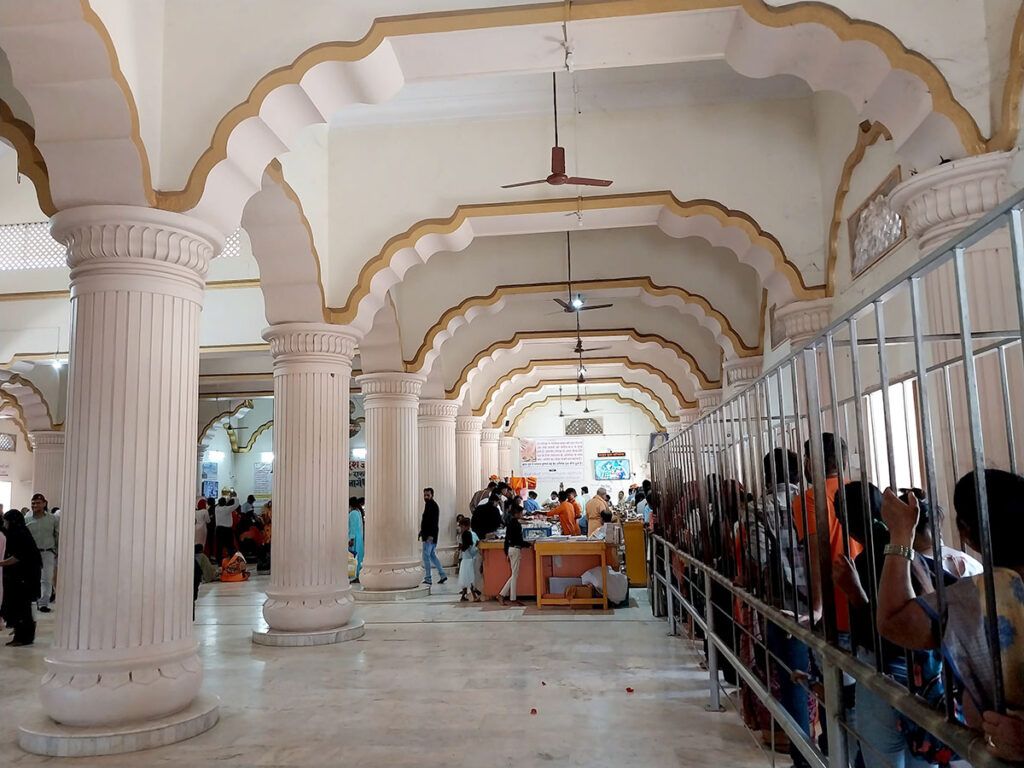Nageshwar Jyotirlinga Dwaraka: 7th CE Temple with Divine Powers
Nageshwar Jyotirlinga Dwaraka is one of the twelve Jyotirlingas, which are the holiest Hindu shrines dedicated to Lord Shiva. It is located in the town of Dwarka, Gujarat, India, and is one of the two Jyotirlingas located in Gujarat.

Contents
- 1 History of Nageshwar Jyotirlinga Dwaraka:
- 2 Legend of Nageshwar Jyotirlinga Dwaraka:
- 3 Significance of Nageshwar Jyotirlinga Dwaraka:
- 4 Myths of Nageshwar Jyotirlinga Dwaraka:
- 5 Nageshwar Jyotirlinga temple timings:
- 6 Controversy with 8th Jyotirlinga:
- 7 Places to visit near Nageshwar Jyotirlinga Dwaraka:
- 8 FAQ:
- 8.0.1 Q: Where is the Nageshwar Jyotirlinga located?
- 8.0.2 Q: What are the entry fees to the Nageshwar Jyotirlinga temple?
- 8.0.3 Q: What are the dress codes for the Nageshwar Jyotirlinga temple?
- 8.0.4 Q: What are the important festivals celebrated at the Nageshwar Jyotirlinga temple?
- 8.0.5 Is Nageshwar Jyotirlinga in Gujarat or Maharashtra?
- 8.0.6 How far is Nageshwar from Dwarka?
- 8.0.7 Why is Nageshwar Jyotirlinga famous?
- 9 How to reach Nageshwar Jyotirlinga Dwaraka:
- 10 Google Maps:
History of Nageshwar Jyotirlinga Dwaraka:
The history of Nageshwar Jyotirlinga Dwarka is long and complex. The temple is believed to have been built by the Pandavas, the heroes of the Hindu epic Mahabharata. According to legend, the Pandavas were exiled from their kingdom for 13 years, and during this time they visited many holy places, including Nageshwar Jyotirlinga.
The temple is also associated with the life of Krishna, another important figure in Hindu mythology. Krishna is said to have visited the temple on several occasions, and he is believed to have performed many miracles there.
Archaeological evidence
Archaeological evidence suggests that the temple has been in existence for centuries. Excavations at the site have revealed ruins of earlier temples, dating back to the 7th century CE.
Modern history
The temple has been renovated and expanded several times over the centuries. The most recent renovation was completed in 2002.
Present day
Nageshwar Jyotirlinga Dwarka is a popular pilgrimage destination for Hindus from all over the world. The temple is especially crowded during the Mahashivaratri festival, which is celebrated in February or March.
Importance
Nageshwar Jyotirlinga Dwarka is one of the twelve Jyotirlingas, which are the holiest shrines dedicated to Lord Shiva in Hinduism. The temple is a place of great spiritual significance for Hindus, and it is believed to offer protection from all kinds of harm.
Read More>> Shivoham Shiva Temple: 65 Foot Tall Statue of Lord Shiva

Legend of Nageshwar Jyotirlinga Dwaraka:
The legend of Nageshwar Jyotirlinga Dwarka is one of the most popular legends associated with the twelve Jyotirlingas. According to the legend, there was once a demon named Daaruka who lived in a forest called Daruka Vana. Daaruka was a very powerful demon, and he terrorized the people of the area.
One day, a devotee of Shiva named Supriya was walking through the forest when he was captured by Daaruka. Daaruka imprisoned Supriya in a cave and threatened to kill him.
Supriya prayed to Shiva for help. Shiva heard Supriya’s prayers and appeared to him in the form of a giant serpent. Shiva scared Daaruka away and rescued Supriya.
Shiva then told Supriya that he would establish his presence in the form of a Jyotirlinga in Daruka Vana. This Jyotirlinga would be known as Nageshwar Jyotirlinga.
The legend of Nageshwar Jyotirlinga Dwarka is a reminder of the power of Shiva’s protection. It is also a reminder of the importance of devotion to Shiva.
Here is a more detailed version of the legend:
In ancient times, there was a demon named Daaruka who lived in a forest called Daruka Vana. Daaruka was a very powerful demon, and he terrorized the people of the area. He would often kidnap people and sacrifice them to his gods.
One day, a devotee of Shiva named Supriya was walking through the forest when he was captured by Daaruka. Daaruka imprisoned Supriya in a cave and threatened to kill him.
Supriya was a very devoted devotee of Shiva. He prayed to Shiva for help, and Shiva heard his prayers.
Shiva appeared to Supriya in the form of a giant serpent. The serpent was so large that it filled the entire cave. Daaruka was terrified by the serpent, and he ran away.
Shiva rescued Supriya from the cave and gave him a boon. He told Supriya that he would establish his presence in the form of a Jyotirlinga in Daruka Vana.
Shiva then disappeared, and Supriya returned to his home.
The next day, Supriya went back to the cave where he had been imprisoned. He found that the cave was now filled with a bright light. The light was coming from a Jyotirlinga, which was now visible in the cave.
Supriya was overjoyed. He knew that this was the Jyotirlinga that Shiva had promised him.
The Jyotirlinga became known as Nageshwar Jyotirlinga. It is one of the twelve Jyotirlingas, which are the holiest shrines dedicated to Shiva in Hinduism.
Read More>> Sacred 12 Jyotirlingas in India: A Symbol of Eternal Spirit

Significance of Nageshwar Jyotirlinga Dwaraka:
Mythological Significance
According to Hindu mythology, the Nageshwar Jyotirlinga emerged when Lord Shiva appeared as a pillar of light (Jyotirlinga) to settle a dispute between Lord Brahma and Lord Vishnu over who was the supreme god. The pillar extended infinitely, challenging both gods to find its end. Lord Brahma took the form of a swan and flew upwards, while Lord Vishnu transformed into a boar and dug downwards. Neither could reach the end, and they were forced to acknowledge Shiva’s supremacy.
Legends and Spiritual Significance
The Nageshwar Jyotirlinga is also associated with the legend of Daruka, a demon who ruled over a forest and imprisoned a Shiva devotee named Supriya. Supriya’s unwavering devotion to Shiva led to the appearance of the Nageshwar Jyotirlinga, which vanquished Daruka and liberated Supriya.
Devotees believe that worshiping at the Nageshwar Jyotirlinga grants them protection from all types of poisons, both physical and spiritual. It is also believed to bestow blessings upon devotees, including spiritual enlightenment, removal of obstacles, and fulfillment of desires.
Architectural Significance
The Nageshwar Jyotirlinga Temple is an architectural marvel, showcasing a blend of ancient and modern styles. The temple complex is divided into three sections: the main sanctum sanctorum, the open courtyard, and the surrounding cloisters. The sanctum sanctorum houses the sacred Nageshwar Jyotirlinga, which is enshrined in a beautifully carved silver altar.
Spiritual Practices and Festivals
The Nageshwar Jyotirlinga Temple is a vibrant spiritual hub, attracting devotees from all walks of life. Daily rituals, including abhishek (bathing the deity with holy water), arati (offering of light), and recitation of mantras, fill the temple with an aura of devotion.
The temple observes numerous festivals throughout the year, including Mahashivaratri, which commemorates the manifestation of Lord Shiva as the Jyotirlinga. During this festival, the temple is adorned with colorful lights and devotees gather to offer prayers and participate in special rituals.
Read More>> Magnificent Ramanathaswamy Temple: A Marvel of Architecture

Myths of Nageshwar Jyotirlinga Dwaraka:
The myth of the Balakhilyas
In ancient times, there was a group of dwarf sages called the Balakhilyas who worshipped Lord Shiva in Darukavana, a forest near Dwarka. Lord Shiva appeared to the Balakhilyas in the form of a naked ascetic wearing only a snake around his waist. The wives of the Balakhilyas were attracted to the ascetic and went after him, leaving their husbands behind.
The Balakhilyas were heartbroken, and they cursed the ascetic to lose his lingam. Shiva’s lingam fell on the earth, and the whole world trembled. Lord Brahma and Lord Vishnu came to Lord Shiva, requesting him to save the earth from destruction and take back his lingam. Shiva consoled them and took back his lingam. He then promised his divine presence in Darukavana as a Jyotirlinga for ever.
The myth of the demon Daruka
In another myth, there was a demon named Daruka who lived in Darukavana. Daruka was a very powerful demon, and he was determined to destroy the Jyotirlinga. He attacked the temple and tried to break the lingam, but he was unsuccessful. Shiva then appeared to Daruka in the form of a giant serpent. He scared Daruka away, and he protected the Jyotirlinga.
The myth of the Pandavas
In the Mahabharata, the Pandavas were exiled from their kingdom for 13 years. During this time, they visited many holy places, including Nageshwar Jyotirlinga. They prayed to Shiva for help, and he promised them that they would return to their kingdom after their exile was over. The Pandavas eventually returned to their kingdom and defeated their enemies.
Read More>> Titwala Ganesh Mandir: Where Devotion Meets Serenity
Nageshwar Jyotirlinga temple timings:
Morning
- Usha Pooja – 5:00 AM to 6:00 AM
- Mahabhishekam – 6:00 AM to 7:00 AM
- Abhishekam – 7:00 AM to 9:00 AM
- Darshan – 9:00 AM to 12:00 PM
Evening
- Aarti – 6:00 PM
- Darshan – 6:00 PM to 9:00 PM
Night
- Deepam – 9:00 PM
- Darshan – 9:00 PM to 12:00 AM
The temple is closed on Tuesdays.
Here are some additional details about the Nageshwar Jyotirlinga temple timings:
- Usha Pooja is a special prayer service that is offered in the morning. It is believed to be a very auspicious time to pray to Lord Shiva.
- Mahabhishekam is a special ceremony that is performed to bathe the Shivlinga with milk, water, and other holy substances. It is believed to be a very purifying and auspicious ceremony.
- Abhishekam is a general term for any ceremony that involves bathing a deity with holy substances. It is a common practice at Hindu temples.
- Darshan is the act of seeing or visiting a deity. It is a very important part of Hindu worship.
The timings of the temple may vary depending on the season and other factors. It is always best to check with the temple authorities before visiting.
Read More>> Sri Puri Jagannath Temple: The Lord of the Universe

Controversy with 8th Jyotirlinga:
There are two main controversies associated with the eighth Jyotirlinga:
The location of the Jyotirlinga
The location of the eighth Jyotirlinga is a matter of debate among Hindus. There are two main contenders for the title: Aundha Nagnath in Maharashtra, India, and Nageshwar Jyotirlinga in Gujarat, India.
Aundha Nagnath is a temple that is believed to have been constructed by the Pandavas, the heroes of the Mahabharata epic. The temple is located in a remote area of Maharashtra, and it is not as well-known as some of the other Jyotirlinga temples. However, it is still a popular pilgrimage site for Hindus from all over India.
Nageshwar Jyotirlinga is a temple that is located in a more central location in Gujarat, India. The temple is larger and more ornate than Aundha Nagnath, and it is also more popular with tourists. However, there is some debate about whether or not Nageshwar Jyotirlinga is the true site of the eighth Jyotirlinga.
Ultimately, the location of the eighth Jyotirlinga is a matter of personal belief. There is no right or wrong answer, and Hindus are free to believe that whichever temple they choose is the true site of the eighth Jyotirlinga.
The caste system and the eighth Jyotirlinga
In the past, the eighth Jyotirlinga was not open to people of all castes. This is because the caste system, which is a social hierarchy that divides Hindus into different social classes, was practiced in India. Under the caste system, people of lower castes were not allowed to enter certain temples, including the eighth Jyotirlinga.
This practice was controversial, as it went against the principles of Hinduism, which teaches that everyone is equal in the eyes of God. In recent years, there have been efforts to make the eighth Jyotirlinga more accessible to people of all castes, and some progress has been made. However, the caste system is still a deeply ingrained part of Indian society, and it is likely to take some time for it to be fully eradicated.
Summary
The controversies surrounding the eighth Jyotirlinga are complex and multifaceted. They reflect the challenges that Hindus face in reconciling their religious beliefs with the realities of modern society. It is hoped that in time, these controversies can be resolved and that the eighth Jyotirlinga can become a symbol of unity and equality for all Hindus.

Places to visit near Nageshwar Jyotirlinga Dwaraka:
Dwarkadhish Temple: This is one of the main attractions in Dwarka and is dedicated to Lord Krishna. The temple is a significant pilgrimage site for Hindus and showcases beautiful architecture.
Bet Dwarka (Dwarka Island): This is an island located nearby, and you can reach it by a short ferry ride. It is believed to be the place where Lord Krishna resided in his childhood. There are temples and archaeological remains to explore.
Rukmini Devi Temple: This temple is dedicated to Rukmini, the consort of Lord Krishna. It is located about 2 kilometers away from Dwarkadhish Temple.
Gopi Talav (Gopi Tank): It is believed to be the place where the gopis (milkmaids) of Vrindavan came to see Lord Krishna. The tank has a small temple on its bank.
Dunny Point: A scenic point where the Gomti River meets the Arabian Sea. It offers a picturesque view of the confluence.
Beyt Dwarka Beach: This is a serene beach near Dwarka with clear waters. You can enjoy some peaceful time here.
Shankhoddhar Island: This island is known for its ancient temple dedicated to Lord Varuna, the god of the ocean. It’s a quiet place with a spiritual atmosphere.
Porbandar: If you have time, you can also visit Porbandar, which is about 100 kilometers from Dwarka. It is the birthplace of Mahatma Gandhi, and there is a Kirti Mandir dedicated to him.
Somnath Temple: While a bit farther away, Somnath Temple is another important Jyotirlinga and a significant pilgrimage site. It is located in the Prabhas Kshetra near Veraval, approximately 250 kilometers from Dwarka.
FAQ:
Q: Where is the Nageshwar Jyotirlinga located?
A: The Nageshwar Jyotirlinga is located in the town of Dwarka, in the state of Gujarat. It is about 10 kilometers from the city of Dwarka.
Q: What are the entry fees to the Nageshwar Jyotirlinga temple?
A: The entry to the Nageshwar Jyotirlinga temple is free. However, there is a fee for Abhishekam and other pujas.
Q: What are the dress codes for the Nageshwar Jyotirlinga temple?
A: There is no dress code for darshan at the Nageshwar Jyotirlinga temple. However, it is recommended to dress modestly.
Q: What are the important festivals celebrated at the Nageshwar Jyotirlinga temple?
A: The Nageshwar Jyotirlinga temple celebrates all the major Hindu festivals, including Shivratri, Maha Shivaratri, and Navaratri.
Here are some more faq’s:
Is Nageshwar Jyotirlinga in Gujarat or Maharashtra?
Its already explained in the above paras, here are some arguments in favor of each location:
Dwarka, Gujarat
- The Shiva Purana, one of the most important texts in Hinduism, explicitly states that Nageshwar Jyotirlinga is located in Dwarka.
- The temple at Dwarka is a major pilgrimage site, and it has been visited by millions of people over the centuries.
Aundha Nagnath, Maharashtra
- The temple at Aundha Nagnath is located in a forest that is said to have been created by the goddess Parvati. This is consistent with the legend of Nageshwar Jyotirlinga’s establishment.
- The temple at Aundha Nagnath is believed to be the original location of the Jyotirlinga. This is supported by archaeological evidence that suggests that the temple was built in the 12th century.
How far is Nageshwar from Dwarka?
Nageshwar Jyotirlinga is located around 16 kilometers from Dwarka in the state of Gujarat, India. The distance is relatively short, and you can easily travel from Dwarka to Nageshwar by road. The journey typically takes around 30 minutes by car or taxi, depending on the traffic and road conditions.
Why is Nageshwar Jyotirlinga famous?
Nageshwar Jyotirlinga is famous for several reasons:
- It is one of the 12 Jyotirlingas, which are the holiest shrines of Lord Shiva in Hinduism. The Jyotirlingas are said to have been established by Lord Shiva himself, and they are considered to be the most powerful representations of the god.
- Nageshwar Jyotirlinga is particularly famous for its association with the legend of the Balakhilyas. The Balakhilyas were a group of dwarf sages who worshipped Lord Shiva with great devotion. Lord Shiva was so pleased with their devotion that he appeared to them in the form of a fiery column of light (jyotirlinga).
- The Nageshwar Jyotirlinga Temple is a beautiful and ancient structure. The temple is said to have been built in the 12th century, and it is one of the most important pilgrimage sites in Gujarat.
- The Nageshwar Jyotirlinga is believed to have the power to protect its devotees from all kinds of harm. The jyotirlinga is said to be particularly effective in protecting people from snakes, and many devotees visit the temple to seek protection from snakebite.
How to reach Nageshwar Jyotirlinga Dwaraka:
By Air: The nearest airport to Dwarka is the Jamnagar Airport (approximately 137 kilometers away). You can also fly to the Rajkot Airport, which is around 224 kilometers from Dwarka. From the airport, you can hire a taxi or take a bus to reach Dwarka.
By Train: Dwarka has a railway station known as Dwarka Railway Station (station code: DWK). It is connected to major cities in Gujarat and other parts of India. Trains from cities like Ahmedabad, Rajkot, and Vadodara operate to Dwarka. Once you reach Dwarka, you can hire a taxi or take a local transport to reach Nageshwar Jyotirlinga.
By Road: Dwarka is well-connected by road to various cities in Gujarat and neighboring states. You can use state-run buses or hire a taxi/private vehicle to reach Dwarka. National Highway 8 (NH8) connects Dwarka to other major cities. Once you reach Dwarka, Nageshwar Jyotirlinga is a short distance away, and you can easily hire local transportation or use your vehicle to get there.
Local Transportation: Once you reach Dwarka, you can hire auto-rickshaws, taxis, or cycle rickshaws to reach Nageshwar Jyotirlinga, which is about 16 kilometers from Dwarka. Many visitors also prefer to hire private cabs or use their own vehicles for convenience.

2 Comments